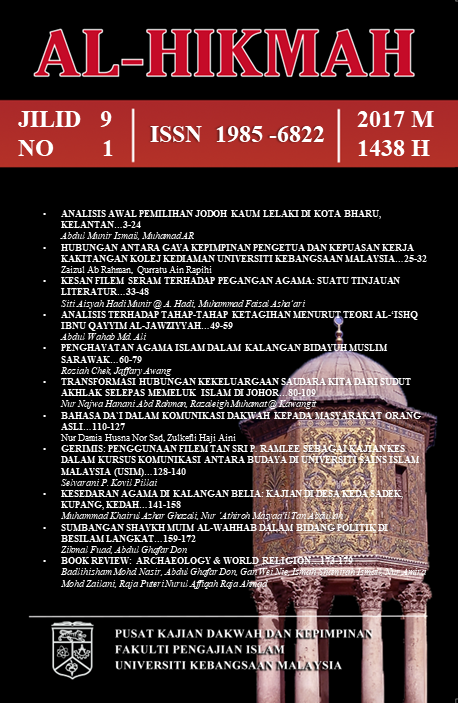THE IMPRESSIONS OF HOROR FILM AGAINST RELIGION: A LITERATURE REVIEW
Kesan Filem Seram Terhadap Pegangan Agama: Suatu Tinjauan Literatur
Abstract
Recently horror film exhibition proceeds either inside or outside the country feared capable of expanding and undermine the faith of community. Data issued by FINAS shows throughout 2003 until today approximately 126 horror films have been screened across the country. Dumping genre film like this shows it's more accepted by the local community. However, this movie dumping feared could undermine the faith as a film may only serve to visually misleading or exaggerating minor things and belittle things. This mistaken view not only raise emotions but will give a wrong perception of religion. This article will discuss the findings of the literature review on the relationship between watching a horror movie with impairment of faith. Focus found that there are five elements that can cause a person to be influenced by the media age, level of education / low IQ level, the frequency of viewing time, traction by media and the low level of religious belief. These elements need to be tested for validity against the effects of the horror film genre.
References
Abd Aziz Itar. 2007. Perbanyakkan filem berunsur keislaman. Utusan Malaysia online, 12 Disember: 15
Adil Akhyar. 2010. Khurafat Alam Melayu. Johor: Pustaka Azhar.
Alexander Darius Ornella. 2014. Film, television and the body. Journal Of Religion, Media & Digital Culture 3(1): 1-7.
Anon. 2006. Kerana VCD Lucah Adik Dirogol Abang. Berita Harian, 8 Mac: P1.
Anon. 2007. Kawal Filem Seram, Tahyul. Berita Harian. 27 Mei: 15
Anon. 2008. Kesan Buruk Filem Hantu. Utusan Malaysia Online. 11 Mei: 5
Armfield, G. G., and R. L. Holbert. 2003. The relationship between religiosity and Internet use. Journal of Media and Religion 2(3): 129-144.
Azhar Ibrahim Alwee. 2006. Pembomohan dan kebertahanannya: Suatu tinjauan kritis. The Reading Group, Singapore.
Bart Peterson. 2011. Media Violence Has Harmful Effects On Young People. Dlm. Noel Merino (pnyt.). Media Violence. United States Of Amerika: Greenhaven Press.
Bjarne M.Holmes dan Kimberly R. Johnson. 2009. Where Fantasy Meets Reality: Media Exposure, Relationships Beliefs and Standarts, And The Moderating Effect Of A Current Relationship. Dlm. Ellen P. Lamont (pnyt.). Social Psychology: New Research. New York: Nova Science Publishers, Inc.
Dale Kunkel. 2011. Television Violence Increase Aggression In Children. Dlm. Noel Merino (pnyt.). Media Violence. United States Of Amerika: Greenhaven Press.
Donald f. Roberts & Wilbur Schramm. 1993. Kanak-kanak belajar daripada media massa. Dlm Terj. Wan Azaham Wan Mohamad & Zainal Abidin Bakar. Proses dan kesan komunikasi massa. Jil 2. Kuala Lumpur: Dewan Bahasa dan Pustaka.
George Gerbner, Larry Gross. 1979. Living With The Television: The Violence Profile. Dlm. Horace Newcombe (pnyt.). Television: The Critical View. Edisi ke-2. New York: Oxford University Press.
George Rodman. 2012. Mass media in a changing world. Edisi ke- 4. New York: McGraw Hill Companies, Inc.
Gerlach V.S & Ely D.P. 1980. Teaching and Media: A systematik approach. Eaglewood Cliffs. New Jersey: Prentice Hall.
Haron Din. 2009. Banyak kesan negatif penyiaran filem seram. Harakah Daily Online. 27 April:3-5
Huesman L.R dan Leonard D. Eron. 1984. Cognitive processes and the persistence of aggressive behavior. Aggressive behavior 10 :243-251
Judith Van Evra. 1990. Television and child development. New Jersey: Lawrence Erlbaum Associates Publishers
Mallick S.K dan McCandeles B.R. 1996. A Study Of Catharsis Of Aggression. Journal of personality and social psychology Jil 4: 591-596.
Mariam F. Alkazemi. 2013. Students’ spiraling silence and willingness to communicate about religion in the united states: an exploration of the media’s role in stigmatizing religion. Journal of Media and Religion 2(1): 1-27.
Mohd Azmi Abdul Hamid. 2011. Isu kemudaratan televisyen: Ke arah Penubuhan Badan Pemantau Televisyen dalam Kalangan Rakyat dalam Pemerkasaan Televisyen. Dlm. Nor Hartini Saari (Penyt.). Mendidik Masyarakat. Kuala Lumpur: IKIM.
Naim Ahmad. 2011. Takut Filem Seram. Utusan Malaysia Online.
Oos Muhammad Anwas. 2003. Pemirsa dan pengaruh televisi dalam budaya dan tatacara hidup. Jurnal Studi Indonesia 14: 90-102
Phil Davignon. 2013. The effects of r-rated movies on adolescent and young adult religiosity: Media as self-socialization. Review of Religious Research 55(4): 615-628.
Rob Nayland dan Chris Near. 2007. Jesus is my friend: religiosity as a mediating factor in internet social networking use. Kertas kerja AEJMC Midwinter Convference. Reno, Nevada. 22-23 Febuari 2007.
Rosly Kayar. 2007. Kelangsangan Dalam Media Dan Kesannya Terhadap Tingkah Laku Agresif Pelajar. Tesis Ijazah Sarjana Pendidikan (Psikologi Pendidikan), Universiti Teknologi Malaysia.
Ruzain Syukur Mansor. 2012. Unsur Khurafat Sebagai Hiburan. Majalah Cahaya: Jabatan Kemajuan Islam Malaysia. Mac: 4-6.
Siti Hanisah Sabri. 2014. Unsur-unsur khurafat dalam filem mistik di malaysia. Latihan Ilmiah Ijazah Sarjana Muda Fakulti Pengajian Islam, Universiti Kebangsaan Malaysia.
Tom Grimes, James A.Anderson, Lori Bergen. 2008. Media Violence and Aggression: Science and Ideology. Sage Publications: United States of America.
Wan Norina Wan Hamat, Zaharah Hussin, Ahmad Fkrudin, Mohamed Yusoff, Ahmad Arifin Sapar. 2013. Pengaruh media massa terhadap penampilan akhlak pelajar Islam politeknik Malaysia. The Online Journal Of Islamic Education 1(1):17-27.
Wilbur Schramm; Jack Layle; Edwin B. Parker. 1961. Television in the lives of our children. Standford University Press: California.
© 2025 Al-Hikmah.
Copyright of the published article is vested in UKM Press, Universiti Kebangsaan Malaysia upon formal acceptance and completion of the copyright transfer agreement.
All articles are licensed under a Creative Commons Attribution–NonCommercial 4.0 International License (CC BY-NC 4.0), which permits non-commercial use, distribution and reproduction in any medium, provided the original work is properly cited.





